Vegetable puree for a child for the winter. Preparation of baby food for the winter at home. Tips for a new mother
Delicate pear puree with a creamy texture is a great option winter harvest. Undoubted dignity of this dessert - the ability to give it to even the smallest children, without fear negative consequences. After all, the minimum amount of sugar and soft, juicy pear pulp create the perfect duet. This baby puree can also be served as a dessert on its own.
To create a recipe, you must select the “right” fruits. They should be sweet, ripe and juicy. Considering that this will be pear puree for the winter for a child, the fruits should be collected in a clean place, away from factories and highways.
Depending on the sweetness of the fruit, you can adjust the amount of granulated sugar in the recipe. The most delicious puree comes from ripe, slightly soft pears that have retained their texture and shape.
If you are preparing pear puree for babies, use small containers. This way you can avoid microbes and bacteria getting into the puree. In addition, this will avoid storing an open jar, the contents of the container small size will be eaten for sure.

How to make pear puree for the winter for a child
Preparing juicy pears: we clean them from a thin skin, remove the seed box. Cut into random pieces and put in a deep saucepan. 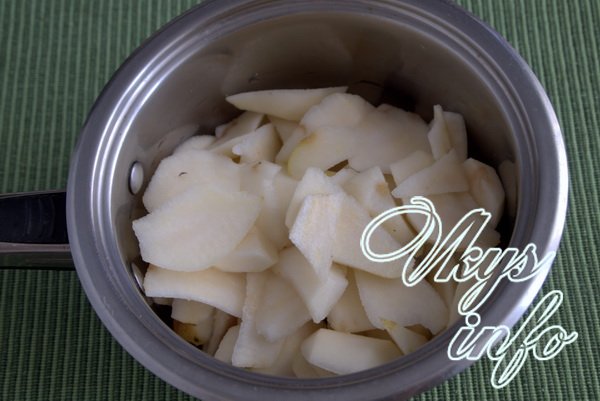
Pour the recommended amount of purified water into the pan. 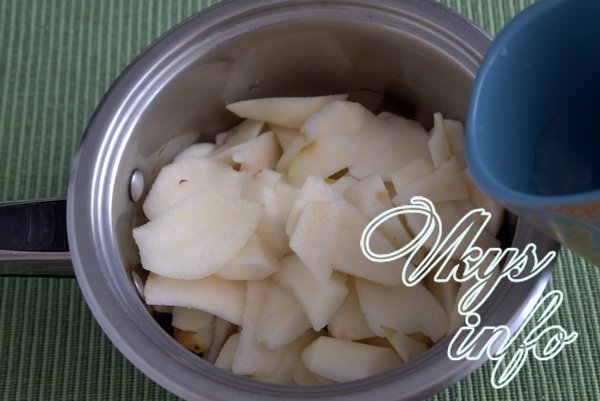
Cook the blank for mashed potatoes for 15-20 minutes until the pear mass becomes soft. 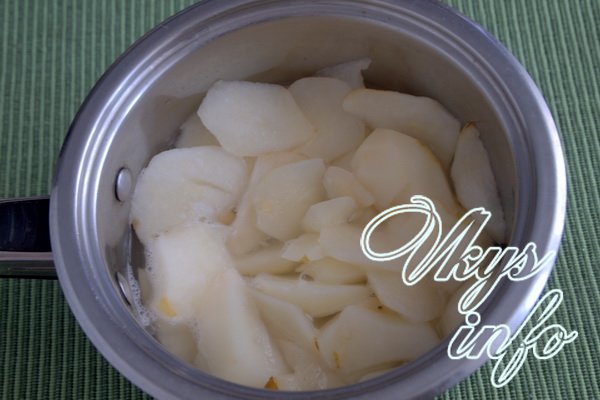
Grind the mass to a homogeneous puree. To do this, use any kitchen blender. 
Pour sugar into a saucepan. Mix the ingredients and cook for another 10-12 minutes. 
Pour the boiling pear puree into a pre-sterilized glass container. 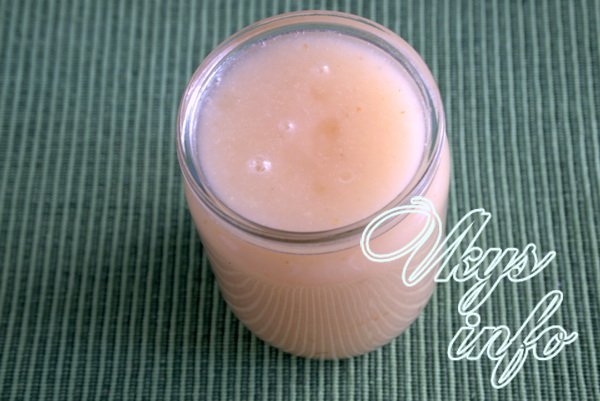
Seal the jars tightly and turn over. We cover the container with baby food with a warm shawl. We store pear puree for the winter for a child in a dark kitchen cabinet or cool pantry. 
Cooking Tips:
- In order to ensure that the jars do not bulge, add a little citric acid to the puree. It will also help to regulate the amount of sugar in the workpiece.
- For the nutrition of babies, fruits should be chosen especially carefully. Such varieties of pears as Conference, Williams Summer (Duchess), Grand Champion, Komis are perfect here. They differ in special juiciness and softness.
- If the puree turned out to be quite thick, you can dilute it with the syrup in which the fruit was boiled.

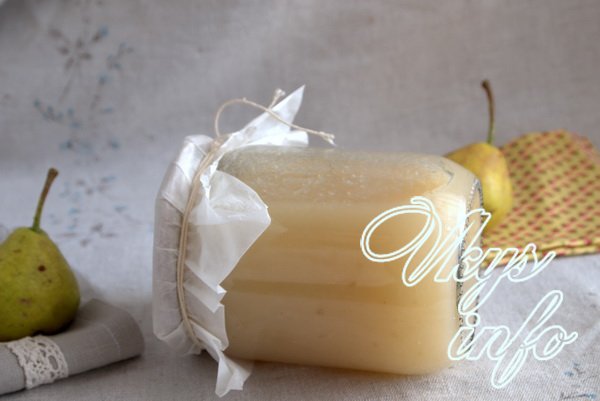
For cooking homemade baby puree are taken ripe and be sure fresh vegetables and fruits. Rinse the selected fruits thoroughly, peel the vegetables. Soft and tender fruits such as strawberries, apricots, peaches can be rubbed raw through a sieve. Harder fruits and vegetables, after washing and peeling, cut and simmer until softened or cooked over low heat. The fruits should be boiled until they become soft, but not too long: the mashed potatoes darken with prolonged cooking.
Softened fruits or vegetables, wipe through a sieve or pass through a meat grinder. Boil the resulting puree for no more than 5 minutes and immediately pour into sterile jars or bottles; fill to the edge of the neck. Seal the container hermetically and place upside down until completely cooled.
If you want to make puree without pre-cooking, it must be poured into jars and sterilized. Fill the jars, leaving 2 cm to the top edge. After sterilization, quickly cool the jars to 40 degrees.
Recipe for baby puree for the winter from plums
To prepare plum puree, take any variety of plums, the main thing is that the fruits are sugary and ripe. Rinse the plums well, cut into halves and heat in a small amount of water. Grind softened plums with a blender or meat grinder. Heat the puree without boiling, and immediately pour into sterilized jars, filling to the brim and corking. Turn over and cool.
Apple baby puree
Rinse the apples well, peel and core, cut into slices. Place the slices in an enamel bowl, cover with water and cook for 15-20 minutes. Wipe hot apples through a sieve or chop in another way convenient for you. Reheat the resulting puree and pour hot into jars. Banks immediately cork, put in a bowl with hot water(80 degrees) and sterilize for 30 minutes.
Love to cook fast? Then we offer you a quick recipe
Pumpkin puree for the winter
Clean the pumpkin from the peel and seeds. Cut the pulp into cubes, put in a saucepan, add a little water and cook until soft over low heat. Grind the mass to a puree state, put on fire again and bring to a boil. Pour the hot puree into jars and roll up.
It's no secret that most of the glossy vegetables and fruits on store shelves during the winter months have not only poor nutritional value, but are also rather stingy. taste qualities. That is why every autumn we rush to prepare delicious, vitamin-rich foods from our garden for the winter.
And we try not only for ourselves. All the best and vitamin, of course, for them, for our flowers of life, for children!
However, everything has its own nuances. For example, it is worth remembering that not all canning methods are suitable for a baby's diet.
Therefore, we tried to combine all the most delicious and healthy in this article.
Puree for the little ones.
 It is worth noting that homemade fruit and vegetable purees are no worse than store-bought ones. Their taste is a little more intense. Consistency - often quite a bit thinner (especially in comparison with mashed potatoes, the consistency of which is "corrected" by the manufacturer using starch, pectin and other relatively harmless stabilizing components). If you are confident in the environmental friendliness of your vegetables and fruits and make mashed potatoes correctly (mandatory boiling, bottling only in sterilized containers), you can use your mashed potatoes even for the first complementary foods. And from 10 to 11 months, it is not only possible, but even better for the baby.
It is worth noting that homemade fruit and vegetable purees are no worse than store-bought ones. Their taste is a little more intense. Consistency - often quite a bit thinner (especially in comparison with mashed potatoes, the consistency of which is "corrected" by the manufacturer using starch, pectin and other relatively harmless stabilizing components). If you are confident in the environmental friendliness of your vegetables and fruits and make mashed potatoes correctly (mandatory boiling, bottling only in sterilized containers), you can use your mashed potatoes even for the first complementary foods. And from 10 to 11 months, it is not only possible, but even better for the baby.
We consider the following purees to be the best proven options “from our own garden”:
- vegetable one-component from zucchini, cauliflower, broccoli;
- vegetable two-component zucchini with potatoes, zucchini with cauliflower or broccoli, cauliflower or broccoli with potatoes;
- fruit apple and apple-pear.
All purees are made in the same way. Let's look at it using apple puree as an example.
Recipe.
Products:
Apples - peeled, with pits and pits removed.
Cooking method:
1. Thoroughly washed, peeled, as mentioned above, cut the apples randomly into slices in an enamel saucepan.
2. Add some clean (filtered) water. Water should not completely cover the fruits, it is only needed so that the apples do not burn during cooking.
3. We put on low heat and cook, covered with a lid, until the apples are soft.
4. As soon as the hearths are soft, remove the saucepan from the heat and “turn” the boiled slices into a fine puree using an immersion blender.
5. We put on low heat and boil for about 15-20 minutes more (the puree should boil a little, but not darken).
6. Pour hot puree into sterilized jars. We seal tightly. 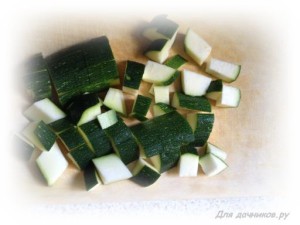
Frozen mixtures for soups and compotes.
I am a big fan of freezing as a way to preserve valuable foods for the winter. Firstly, it allows you to save a fairly large (compared to other methods) part of the vitamins in vegetables and fruits. And for a child's diet, this is very important.
Secondly, frozen mixes are very convenient. They have helped our family many times.
Cooking a delicious vegetable soup for a baby in winter with their help is a matter of a few minutes. It is enough to put the mixture in a saucepan with boiling water, and after cooking, add the meat (separately cooked, of course). For the little ones, boiled vegetables with broth and meat can be turned into mashed soup using a blender.
It's also easy to make a delicious berry compote from a frozen mix.
Preparing the mixture itself in season is as easy as shelling pears. Its composition usually depends on your taste. I will talk about the preparation using the example of one of the mixtures for vegetable soup, which I am preparing for my child.
 Recipe.
Recipe.
Products:
A small young squash, a few tomatoes, bell pepper, carrot.
It is worth mentioning right away that I also put non-frozen potatoes and onions in the soup, because. they are perfectly stored and without freezing. But to simplify further cooking, if desired, they can also be frozen in a mixture with the indicated vegetables.
Cooking method:
1. Wash vegetables thoroughly, clean carrots and zucchini.
2. Cut all vegetables except carrots into small cubes, approximately the same size. Three carrots on a coarse grater.
3. Mix, pack in sachets. A serving in a bag is for one brew.
4. Put it in the freezer. If it is possible to regulate the temperature of the freezer (the function is present in almost all modern refrigerators), turn it on for 3-4 hours at maximum, then at -18C. The faster the vegetables freeze, the more vitamins will remain in them.
Sweet for older kids. 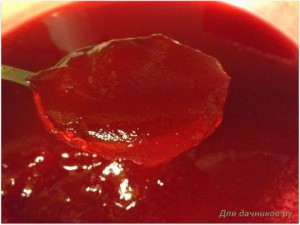
Well, what child does not like sweets? And who would argue that homemade preserves and jams are much more preferable in the child's menu than cakes, sweets and sweet bars.
Speaking of bars. Up to a certain age, purchased ones with many E-components are easy to replace with delicious homemade ones. It is easy to make them by chopping dried fruits (dried apricots, prunes, figs) and nuts and making bars from the resulting mass. I also add some honey to them. But this is a digression.
So that's about jams and jams. They are certainly not as harmful as purchased sweets. And yet cooking "kills" a very important part of the vitamins. First of all, vitamin C is destroyed, which, oh, how our children need in winter. Therefore, we started introducing sucrose into the diet for our child with the most useful products- jams without cooking. These include red and blackcurrant jams. They are extremely useful in the autumn-winter period, because they retain absolutely all the benefits of fresh berries.
Redcurrant jam recipe we printed
Of course, there are many more useful ways save healthy vegetables and fruits for children for the winter. Drying is one of them. Dried apples, for example, are good for compote, and you can eat them just like that.
But fermented and even more so pickled foods are not recommended for babies. Many people think that if a product without vinegar is fermented natural way, then it will be harmless to the child. However, during fermentation, many fermentation products are formed, which the child does not need at all. Yes, and such products are difficult for a child's body, in which there are still not enough enzymes to digest them.
If you also have branded recipes for the winter for kids, we will be grateful if you share them in the comments!
The task of every mother is to provide the child with healthy and fortified nutrition. all year round. But in summer period it turns out much easier, everything is fresh, natural, but with the advent of winter, many parents begin to think about what blanks baby food for the winter can cook?
There are more than enough different purees and mixtures in supermarkets, but there are only preservatives and GMOs. Baby food for the winter can be prepared in at home. The main thing is to harvest them at the time when their season begins so you save all the vitamins and minerals that the child needs. The benefits of such nutrition will be only if it is prepared from natural fruits and vegetables.

Preparing baby food for the winter: ways
There are two types of baby food preparations for the winter.
- Freezing is the most popular method. This method perfectly preserves all the useful substances. It is necessary to wash the berries, sort them out, throw out rotten or spoiled ones, dry them naturally, put them in a special container (you can attach a leaflet with the inscription what is in it) or a plastic bag. You can freeze both berries and fruits with vegetables.
- Preservation is a great way to prepare mashed potatoes for baby food for the winter. Puree is an excellent side dish for meat and fish. You can close any puree from apples, pears, plums, peaches, zucchini, carrots, beets, broccoli, cabbage, etc. You need to prepare the products as indicated in the first method - freezing. Then put the chopped product in a saucepan, pour cold water and cook for 15 minutes. Then mash to a smooth consistency with a blender or with a sieve. Then we put it back in the pan, add granulated sugar and boil for 10 minutes. Be sure to sterilize the jar and lid. Store in a cool, dark place.
But then mothers have a question, what winter baby food recipe select? Which fruit or vegetable do you prefer? Consider the most popular recipes for children.
Baby food from apples for the winter
We prepare apples, as for freezing. Then in a saucepan and cook for 15 minutes, remove, mash, put in a saucepan and cook again, boil for 10 minutes. We put it in a jar sterilized with boiling water and roll it up with a lid, let it cool, and put it in a cool, dark place. Also, delicious puree from apples and zucchini, apples and pears is prepared in the same way.
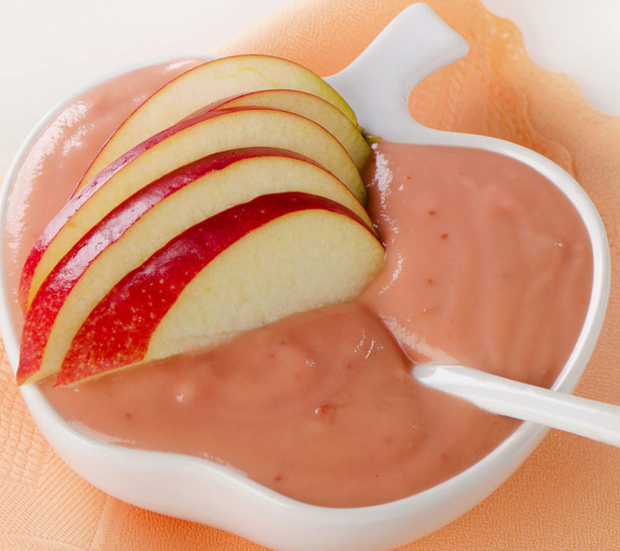
Zucchini for the winter for baby food
Prepare zucchini as you would for freezing. We canned, like apple food. An excellent combination of zucchini with carrots, zucchini with cauliflower or apple. Puree can be preserved with or without granulated sugar.
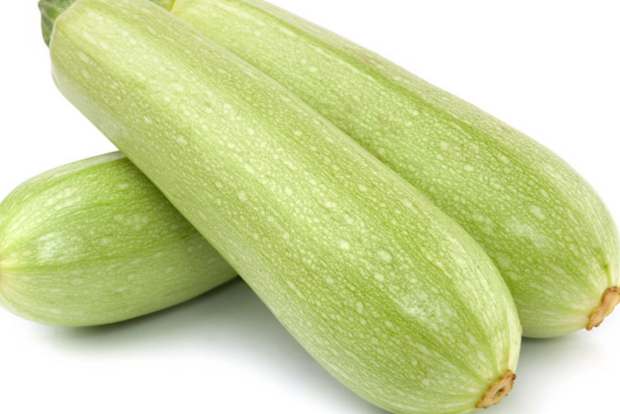
So, despite the winter frosts, let your baby get all the necessary and useful vitamins, thanks to the baby food prepared by his mother with love!
If you find an error in an article, please highlight a piece of text and click Ctrl+Enter.
Top news
Anastasia Lukina.
Pretty interesting preparation for the winter, recently gaining great popularity, is considered fruit puree. The thing is that there are plenty of reasons for wasting time and effort on such a blank, and they are all quite important. For example, if you don't want to bother making jam, or if there's an excess of fruit crops, purée is a great alternative to regular seamings like , jam, juice or jelly.
Well, if you have Small child, then you simply cannot do without such a winter preparation, which can later be used as an excellent complementary food, because mashed potatoes are the main dish in the diet of not only infants, but also children up to two years old. The main positive point in using such baby food is that the body receives not only delicious food, but also minerals, trace elements and vitamins. Of course, in any store and supermarket is always in stock wide choose various types of mashed potatoes, but caring mothers like you prefer to cook such a delicacy at home, using natural and high-quality products. However, you should know that puree industrial production undergoes a mandatory check at all stages of its creation before the finished seaming appears on the shelves in the store. And by the way, for homemade puree must adhere to the list of mandatory rules.
The main point concerns the choice of fruits, since you must purchase fruits that have not been chemically processed. For the preparation of baby puree, only natural and ripe berries and fruits. You can choose the consistency of the dish at your discretion. Also, all containers, from those in which you will cook, and ending with jars, must be sterile and thoroughly washed.
Fruit puree preparation, among other things, can be a good filling for pies, pies, and also served as an independent dish as a dessert. They can also be poured over ice cream, and lovers of unusual flavors can use it as a side dish or sauce for meat dishes.
Preparing fruit rolls for the winter- this is a completely simple procedure, and you can master it the first time.
Prepare fruit puree can be from any berries and fruits, for these purposes are perfect: apples, apricots, pears, plums, peaches and even avocados, mangoes, bananas and other exotic fruits.
If the preparation is prepared specifically for a child, then it is better to use a pear, apple, nectarine, peach and apricot, since these fruits rarely cause allergic reactions in babies.
Almost all varieties of fruit puree are prepared according to the following technology: first, the fruits are baked in the oven, or boiled until soft, then the pulp is separated from the skin and seeds, and finally kneaded well. This method is good when you serve fresh dish, but with conservation, the situation is a little different, because the puree must be prepared so that it does not sour in a week. All in all, detailed technology, process and recipe

Harvesting apple puree for the winter. Recipe
Ingredients:
1. Wash the apples, peel them with a special vegetable peeler, cut in half, remove the middle and chop into small cubes. Take enamel pan and put some fruit in there. Pour some clean water and simmer for about five minutes until the apples are soft.
2. Remove the pan from the stove and let the mass cool down at room temperature. Grind the cooled, soft pieces through a sieve, or grind with a blender until smooth.
3. Wash jars and lids and, be sure, sterilize. Put applesauce on fire and bring to a boil. Stir and you can immediately pour into prepared, sterilized jars. Wrap and wrap.
Such a puree is best prepared from apples of more acidic varieties. You can add sugar and spices to the workpiece, to taste, but only if you are cooking for yourself, and not for an infant.

Harvesting mashed pears for the winter. Recipe
Ingredients:
1. Citric acid
1. Wash the pears, dry and peel, even if it is soft. Remove the seeds and cut into small pieces. Transfer to an enamel pan, pour a little drinking water and simmer over medium heat until soft.
2. Grind until smooth with a blender and bring the mixture to a boil. To prevent the delicacy from being too sugary, add a little citric acid, literally at the tip of a knife. By the way, you can replace citric acid fresh lemon juice, or other more acidic puree, such as apple or plum.
Plum and peach puree blanks are prepared using exactly the same technology. If you are not making a delicacy for small children, then you can add other ingredients and spices there, at your discretion. Now you know that making pears, peaches, plums or apples puree is not at all difficult.
Harvesting puree from apples and pumpkins for the winter. Recipe
Ingredients:
1. Apples - 1 kg
2. Pumpkin - 1 kg
3. Chopped orange (lemon) zest - 1 tsp.
4. Sugar - to your taste
1. Peel the pumpkin, do it carefully, as it is quite difficult. Also peel the apples and remove the seeds. Cut the fruits into small cubes and transfer to a saucepan. You can use a slow cooker or steamer. Cover with water and simmer until pumpkin is soft.
2. Grind hot fruits into puree, in any way convenient for you, add a teaspoon of grated zest, and sugar.
3. Put the puree on medium heat and bring to a boil, stirring constantly. Pour into clean jars and sterilize for about ten to twelve minutes. Seal, wrap and leave to cool.
If the puree turned out to be more liquid than you would like, then boil it on the stove to a thicker, viscous state.
Homemade fruit puree- it is very tasty and healthy. Such a treat will appeal not only to children, but also to adults. And there are a lot of ways to use it, unless, of course, there is at least one jar left.
Video cooking lesson applesauce at home





